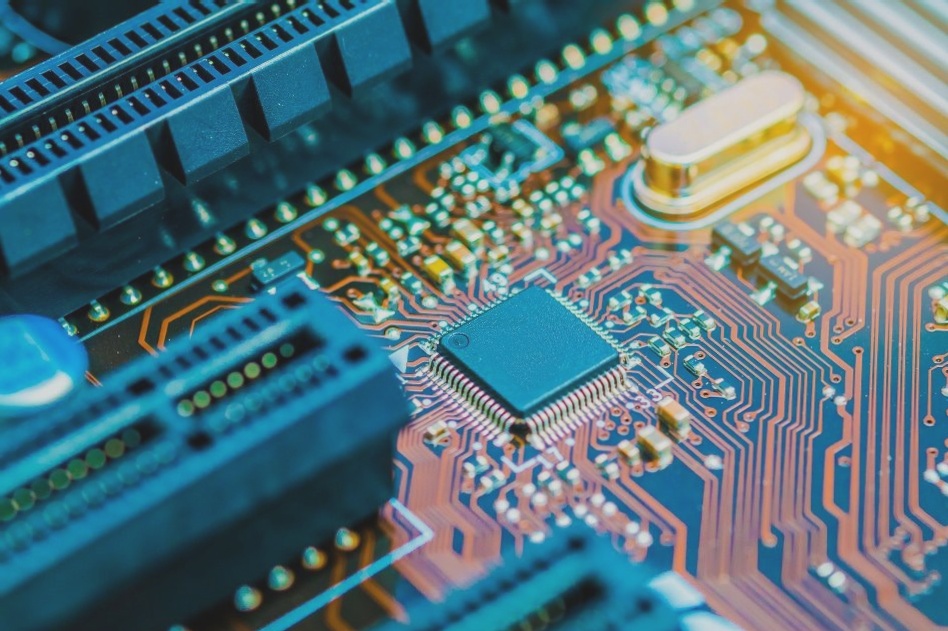3.) The latitude and longitude of the prepreg:
Upon lamination, the prepreg experiences differential shrinkage rates along its warp and weft axes. It’s crucial to distinguish between these directions during blanking and lamination to prevent post-lamination warping of the finished board, which can be challenging to rectify even with applied pressure during baking. Many instances of multilayer board warpage stem from the improper identification of prepreg warp and weft directions during lamination, leading to random stacking.
How can one discern the warp and weft directions? The roll-up direction of the prepreg denotes the warp, while its width signifies the weft direction. For copper foil boards, the longer side indicates the weft, and the shorter side indicates the warp. If uncertain, consulting the manufacturer or supplier is advisable.
4.) Stress relief post lamination of PCB thick copper plates:
Following hot and cold pressing, the multilayer PCB undergoes deburring through cutting or milling. Subsequently, it’s placed flat in an oven set at 150 degrees Celsius for 4 hours. This gradual heating process facilitates stress release within the board and ensures complete resin curing, an indispensable step that must not be overlooked.
5.) Straightening during plating:
For 0.4 to 0.6mm ultra-thin multilayer boards used in surface electroplating and pattern electroplating, specialized clamping rollers are imperative. Once the thin plate is affixed onto the flybus of the automatic electroplating line, a cylindrical rod is utilized to clamp the entire flybus. These rollers are threaded together to straighten all plates, preventing post-plating deformation. Without this precaution, copper layers of 20 to 30 microns may cause bending, posing significant challenges for rectification.
6.) Cooling of the board after hot air leveling:
Upon hot air leveling, PCB thick copper plates endure the solder bath’s high temperature (approximately 250 degrees Celsius). Subsequently, they should be laid flat on a marble or steel surface for natural cooling before undergoing post-processing cleaning. This practice mitigates board warpage. While some factories opt to enhance the lead-tin surface’s brightness by immediately immersing boards into cold water after hot air leveling, this abrupt thermal shift may induce warping, twisting, or blistering in certain board types. Installing an air flotation bed for cooling can be an alternative.
7.) Treatment of warped boards:
In well-managed PCB facilities, every printed board undergoes 100% flatness inspection during final checks. Any non-compliant boards are segregated and subjected to baking at 150 degrees Celsius under substantial pressure for 3 to 6 hours. After natural cooling under pressure, the boards are assessed for flatness. This process salvages some boards, while others may require repeated baking and pressing before achieving proper leveling. Failure to implement these anti-warping measures may render some boards unusable, necessitating scrapping.
Upon lamination, the prepreg experiences differential shrinkage rates along its warp and weft axes. It’s crucial to distinguish between these directions during blanking and lamination to prevent post-lamination warping of the finished board, which can be challenging to rectify even with applied pressure during baking. Many instances of multilayer board warpage stem from the improper identification of prepreg warp and weft directions during lamination, leading to random stacking.
How can one discern the warp and weft directions? The roll-up direction of the prepreg denotes the warp, while its width signifies the weft direction. For copper foil boards, the longer side indicates the weft, and the shorter side indicates the warp. If uncertain, consulting the manufacturer or supplier is advisable.
4.) Stress relief post lamination of PCB thick copper plates:
Following hot and cold pressing, the multilayer PCB undergoes deburring through cutting or milling. Subsequently, it’s placed flat in an oven set at 150 degrees Celsius for 4 hours. This gradual heating process facilitates stress release within the board and ensures complete resin curing, an indispensable step that must not be overlooked.
5.) Straightening during plating:
For 0.4 to 0.6mm ultra-thin multilayer boards used in surface electroplating and pattern electroplating, specialized clamping rollers are imperative. Once the thin plate is affixed onto the flybus of the automatic electroplating line, a cylindrical rod is utilized to clamp the entire flybus. These rollers are threaded together to straighten all plates, preventing post-plating deformation. Without this precaution, copper layers of 20 to 30 microns may cause bending, posing significant challenges for rectification.
6.) Cooling of the board after hot air leveling:
Upon hot air leveling, PCB thick copper plates endure the solder bath’s high temperature (approximately 250 degrees Celsius). Subsequently, they should be laid flat on a marble or steel surface for natural cooling before undergoing post-processing cleaning. This practice mitigates board warpage. While some factories opt to enhance the lead-tin surface’s brightness by immediately immersing boards into cold water after hot air leveling, this abrupt thermal shift may induce warping, twisting, or blistering in certain board types. Installing an air flotation bed for cooling can be an alternative.
7.) Treatment of warped boards:
In well-managed PCB facilities, every printed board undergoes 100% flatness inspection during final checks. Any non-compliant boards are segregated and subjected to baking at 150 degrees Celsius under substantial pressure for 3 to 6 hours. After natural cooling under pressure, the boards are assessed for flatness. This process salvages some boards, while others may require repeated baking and pressing before achieving proper leveling. Failure to implement these anti-warping measures may render some boards unusable, necessitating scrapping.



